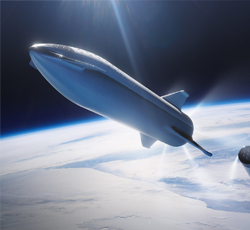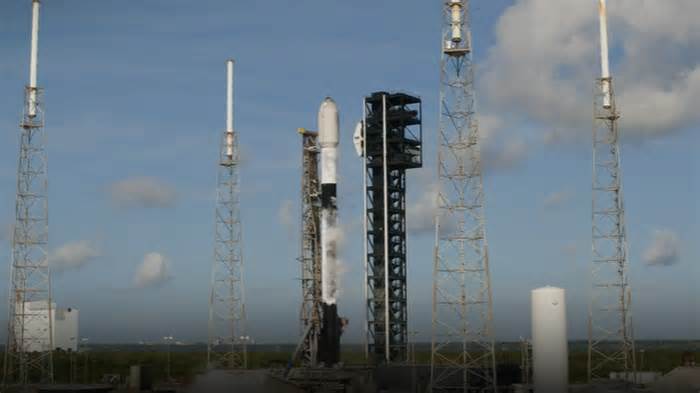
SpaceX Falcon Heavy launch of secretive mini shuttle delayed, no new launch date yet - Orlando Sentinel
- by Orlando Sentinel
- Dec 11, 2023
- 0 Comments
- 0 Likes Flag 0 Of 5

December 13, 2023 at 8:05 AM EST
KENNEDY SPACE CENTER — SpaceX pushed one day for weather and has delayed again the next Falcon Heavy launch of a secretive spacecraft that’s a fourth the size of the space shuttle.
“Standing down from tonight’s Falcon Heavy launch due to a ground side issue; vehicle and payload remain healthy,” SpaceX posted on X less than an hour before Monday’s planned liftoff. “Team is resetting for the next launch opportunity of the USSF-52 mission.”
While SpaceX had initially targeted Wednesday for its next attempt, the company posted to X late Tuesday that it was calling off that attempt as well.
“We are standing down from tomorrow’s Falcon Heavy launch of USSF-52 to perform additional system checkouts. The payload remains healthy while teams work toward the next best launch opportunity. We’re also keeping an eye on the weather and will announce a new launch date once confirmed with the Range,” SpaceX posted on X.
Falcon Heavy, making only its ninth launch, is essentially three Falcon 9 rockets strapped together, which produce 5.1 million pounds of thrust on liftoff, the most powerful rocket available for regular launches.
The two side boosters are making their fifth flight and will attempt a recovery landing at nearby Cape Canaveral Space Force Station’s Landing Zones 1 and 2. Their return after liftoff will bring the signature double sonic booms for each booster for many along the Space Coast, although the house-rumbling sound could be heard deeper into Central Florida as well.
Personnel attend to the Boeing X-37B after one of its previous landings. (Courtesy/Boeing Space)
The rocket’s payload is the secretive X-37B Orbital Test Vehicle built by Boeing. The uncrewed spacecraft that resembles a miniature space shuttle first flew to space in 2010 and is now heading up for its seventh trip. Each mission, the vehicle has had longer duration missions. Its sixth trip that concluded last November with a touchdown at the former Shuttle Landing Facility at KSC lasted nearly 909 days.
To date, the spacecraft has traveled more than 1.3 billion miles and spent more than 3,774 days in space.
Previous launches have used either Atlas V or Falcon 9 rockets for liftoff, but Falcon Heavy’s power could be a factor in the latest mission for the spacecraft, which is headed for “new orbital regimes,” according to a Space Force press release.
“We are excited to expand the envelope of the reusable X-37B’s capabilities, using the flight-proven service module and Falcon Heavy rocket to fly multiple cutting-edge experiments for the Department of the Air Force and its partners,” said Lt. Col. Joseph Fritschen, the X-37B program director.
The X-37B featuring the United States Space Force logo for the first time. (Courtesy/U.S. Space Force)
That includes NASA, which is hitching a ride for an experiment called Seeds-2, which will expose plant seeds to harsh radiation during the long-duration flight. That falls in line with NASA’s attempts to prepare humans for trips to Mars and beyond.
Just what else the X-37B does in space, and where exactly it flies, remains mostly classified, but the Space Force’s Chief of Space Operations Gen. B. Chance Saltzman called the experiments “groundbreaking.”
“The X-37B continues to equip the United States with the knowledge to enhance current and future space operations,” he said. “X-37B Mission 7 demonstrates the USSF’s commitment to innovation and defining the art-of-the-possible in the space domain.”
For the record, the Space Force says the spacecraft’s test technologies for domain awareness are “integral in ensuring safe, stable, and secure operations in space for all users of the domain.”
USSF-52 marks Falcon Heavy’s third mission for the Space Force, all within the least year.
The rocket first flew in 2018 sending up Elon Musk’s Tesla on a trip out past Mars. It only flew two more times in 2019 before taking more than a three-year break, but then began launching regularly beginning with SpaceX’s first Falcon Heavy mission for the Space Force last fall. That was followed by four more missions in 2023 — another Space Force launch, two commercial satellite launches and its first-ever launch for NASA this past October when it sent up the Psyche probe for its six-years-long mission to explore a metallic asteroid.
For this fifth flight of 2023, the head of the Space Force’s Assured Access to Space program, Brig. Gen. Kristin Panzenhagen, who is based at Patrick Space Force Base and is also in charge of Space Launch Delta 45 and the Eastern Range, said teams have been resilient with the higher cadence of launches.
“Our team has done amazing work to prepare for this critical launch, and we’re doing even more behind the scenes,” she said. “We are honing our processes to make our launch capabilities even more responsive to national security needs. We are also making our spaceports more resilient to ensure that our ability to place capabilities into orbit never falters.”
Please first to comment
Related Post
Stay Connected
Tweets by elonmuskTo get the latest tweets please make sure you are logged in on X on this browser.






 Energy
Energy

















